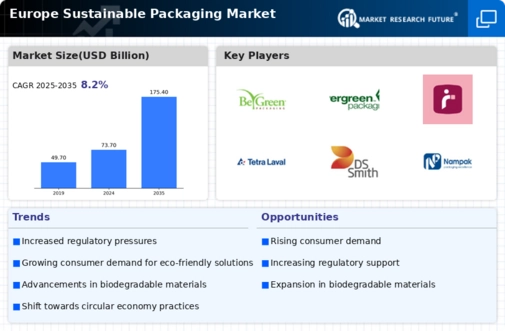Europe Sustainable Packaging Market Summary
The Europe Sustainable Packaging market is projected to grow significantly from 73.69 USD Billion in 2024 to 175.38 USD Billion by 2035.
Key Market Trends & Highlights
Europe Sustainable Packaging Key Trends and Highlights
- The market is expected to expand at a compound annual growth rate of 8.2 percent from 2025 to 2035.
- By 2035, the market valuation is anticipated to reach 175.4 USD Billion, reflecting a robust growth trajectory.
- in 2024, the market is valued at 73.69 USD Billion, indicating a strong foundation for future expansion.
- Growing adoption of sustainable materials due to increasing environmental regulations is a major market driver.
Market Size & Forecast
| 2024 Market Size | 73.69 (USD Billion) |
| 2035 Market Size | 175.38 (USD Billion) |
| CAGR (2025-2035) | 8.20% |
Major Players
Be Green Packaging, Amcor, Evergreen Packaging, Mondi, Tetra Laval, Sonoco Products Company, TetraPack International Company, DS Smith, Nampak, Sealed Air Corp


















Leave a Comment